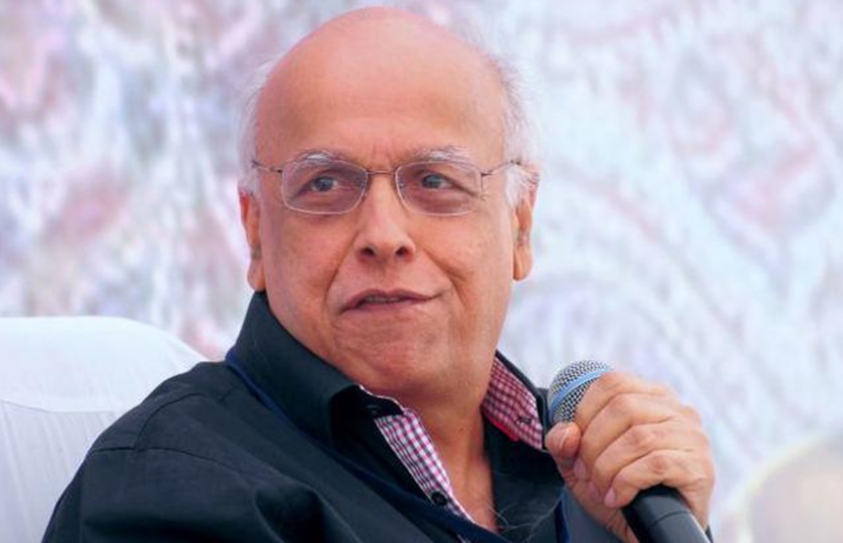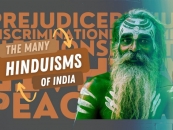
Why Mahesh Bhatt Worked on Hamari Adhuri Kahani Without Remuneration
by Vinta Nanda June 10 2015, 4:28 pm Estimated Reading Time: 8 mins, 9 secs“I didn’t take a penny for my work on Hamari Adhuri Kahani!”– Mahesh Bhatt
A Klee painting named ‘Angelus Novus’ shows an angel looking as though he is about to move away from something he is fixedly contemplating. His eyes are staring, his mouth is open, his wings are spread. This is how one pictures the angel of history. His face is turned towards the past. Where we perceive a chain of events, he sees one single catastrophe, which keeps piling wreckage upon wreckage and hurls it in front of his feet. The angel would like to stay, awaken the dead, and make whole what has been smashed. But a storm is blowing from Paradise; it has got caught in his wings with such violence that the angel can no longer close them. This storm irresistibly propels him into the future to which his back is turned, while the pile of debris before him grows skyward. This storm is what we call progress (Benjamin 1969:257–8)
Why are we afraid of telling modern and contemporary stories honestly; and why is it that we take support of technology, statistics and society to give sanction to our denial?
Technology is an evolving science and art the angel in context to the above extract from ‘Catastrophe and Survival: Walter Benjamin and Psychoanalysis’ by Elizabeth Stewart. Art either leads technology or else rides the storm once its breakthroughs get off the ground.
When an abstract expression of an artist captures the imagination of a large number of people at one shot, there is disbelief only because its moorings are not rooted in science.
Rejection of every formula happens right till such time that it is proven to be true scientifically; and it is invariably the community of artists within societies, who accept and explore the idea, before the system does.
Artists, writers, poets, singers, lyricists, musicians and dancers understand each other and like all scientists, emerge from societies.
They don’t come from some faraway land that nobody has ever heard of before; but often get treated by their communities like they do.
Evolving technologies on the other hand, are tools that governments must guarantee to societies; because when technologies collide with local arts,the amplification ofevolving expression takes place through media au courant.
It is only then that media is able to impact society; it is able to “afflict the comfortable, and comfort the afflicted”, as very eloquently said by Finley Peter Dunne, a humorist, cartoonist and writer from Chicago who lived from 1867 – 1936.
It is the consistent progression of the above hypothesis, which helps cultures to grow and supports creation of indigenous infrastructures that enable civilizations to stay acquainted with modern and emerging development paradigms.
My friend from school came visiting the other day.
We were meeting after about 25 odd years, and I asked her how life and her art were going for her.
She was a great Kathak (classical Indian form of dance) dancer in school and thereafter until I lost touch with her, I remembered she was performing professionally regularly.
She had a faraway look in her eyes as she told me that she had given it up.
I was shocked.
No way! Not her!
She used to love to dance! Dance was what her soul was in union with.
On probing further she said her marriage, her kids, their education, then her daughter’s career and her recent marriage; gave her no time to pursue her art; and that now that she was done with most of her duties, she was looking for ways to either go back to dancing or else find another form of creative expression.
Like my friend Nirupama, almost every woman’s journey is an unfinished story, I thought, as I looked back at my own life and saw at how many places I had compromised myself.
We forsake our passion, our desires and our ambitions for our men, our children, our families; we obey the order for fear of isolation.
We accept the norm and submit to status quo because we are fear being abandoned by the very people whom we love and who love us.
Ironically, I was floating around in that state of mind until late evening, when I happened to meet Mahesh Bhatt, and realized that ‘HamariAdhuriKahani’ is a story that deep dives to, and explores similar sensitivities.
And I asked him how he was feeling on the eve of the release of his latest production? My question, made him thoughtful.
He then said, quietly, “This is the first film that I’ve written and produced, for which I have not taken a single naya paisa as remuneration.”
After a long silence, he spoke again, ‘There is too much happening around us; too many theories doing the rounds about what kind of cinema works and what kind of storytellingdoesn’t, what audience wants and what it doesn’t want anymore. I’m confused as a storyteller about what a certain demographic accepts and what it rejects; and in all that chaos, when as narrators you don’t know what to follow, you resign to the conflicting forces that surround you and blindly chase the guys who have the money to pay you to do your job.”
“When we abandon what our instincts lead us to do, and when we turn deaf to our own inner voice, it is in that where we start going wrong with the story we want to tell”, he continued.
So he said he didn’t accept money for writing the story of ‘Hamari Adhuri Kahani’, and told the studio to either go with what he gave them or else throw the story along with himself out of the window; but he told them that this one time, he was not going to give them the permission to interfere with his process!
That, he said, was the only way he could tell the story from his heart and the heart, he said, is all that he thinks can connect with a diverse set of audiences, collectively.
Creative people can’t stop discovering solutions to the problems faced by art in the same way, as scientists cannot stop thinking of finding solutions to prove their own science.
It is the infinitesimal universe that both creativity and science belong to, which keeps awe and wonder alive in the heart of both the artist and the scientist; and it is the dissatisfaction with the current process what keeps them returning to drawing boards and going back to finding new ways to redefine the status quo.
There is no end to either the thirst or to the quest for both.
There are no borders,there are no boundaries.
Thus art, like science, progresses, evolves and becomes available to its appreciators in a myriad of forms that synchronize with time, space and the moment that cradles its expression.
The form in which every artist places her art, to me is technology and media is the amplification of the metaphor which dominates a collective conscience each time; sometimes seductive, sometime haunting, sometimes tormenting and sometimes caressing to the soul with which it connects.
In such abstractions, to which both science and art belong, it is but necessary to respect them in equal measure and not differentiate between the two.
Media, technology and art are individual institutions that societies lean on, and the subtle integration of the three is what defines cultures, politics, economics and wellbeing eternally.
To make any of the three merge with another is a deliberate attempt to stagnate society and coerce it to stall evolution; and to deny any one of the three to society is to intentionally postpone development.
At the end of the day, every society is the sum total of the stories it listens to through the mediums available to it.
Where there is no technology and media, art stagnates.
Where there is no art and media, technology deteriorates; and where there is no technology and art, there is a repetitive or vacant media.
Technology accelerates growth; it provides people with tools to advance and equalize; to feel included. It creates a wireframe for a people to become one in union with each other. The web it casts is the stage, the set up for media, which compounds and magnifies art, performance, photography, cinema, storytelling, music, dance and every other expression of artists from across the world.
Let us not get confused or for that matter allow technology to overwhelm us to such an extent, that we find ourselves bereft of stories to tell or realize that we are repeating ourselves for fear of rejection.
When a stalwart who has proved himself over and over again comes to a place where, just to connect his heart to the beat of the societies he speaks to, he has to forgo his pay check; its time to realize that we have conceded to technology and ended up paying a heavy price for the story which instead of liberating us, has us enslaved.
As he walked away to the comfort of his den that evening, when I was still nursing the pain of not having yet got my own personal life story to the roads which will lead it towards accomplished culmination; Mahesh Bhatt rounded off the discussion in his typical style by saying, ‘Many sciences and technologies have been instrumental in bringing nations, places and people closer, and in connecting them to each other; but there is yet no technology, science nor media which has the ability to connect the hearts of people, except for an honestly told story.”




-173X130.jpg)
-173X130.jpg)
-173X130.jpg)
-173X130.jpg)

-173X130.jpg)
-173X130.jpg)
-173X130.jpg)